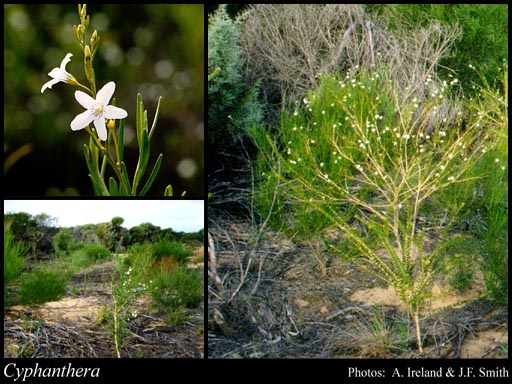- Reference
- Ann.Mag.Nat.Hist. p376 (1853)
- Name Status
- Current







Scientific Description
Family Solanaceae.
Habit and leaf form. Shrubs; resinous, or not resinous. Plants unarmed. Stem internodes solid. Helophytic, or mesophytic, or xerophytic. Leaves alternate; spiral; ‘herbaceous’, or leathery; petiolate (rarely), or sessile; non-sheathing; gland-dotted, or not gland-dotted; aromatic, or without marked odour, or foetid; simple. Leaf blades entire; flat; narrowly elliptic to ovate (to broadly ovate), or oblong, or obovate, or triangular, or linear; pinnately veined; cross-venulate; cordate (triangular leaf). Leaves without stipules. Leaf blade margins entire; revolute (recurved). Leaves without a persistent basal meristem. Leaf anatomy. Hairs present, or absent; glandular hairs absent, or present. Extra-floral nectaries absent.
Reproductive type, pollination. Fertile flowers hermaphrodite. Unisexual flowers absent. Plants hermaphrodite. Entomophilous.
Inflorescence and flower features. Flowers solitary, or aggregated in ‘inflorescences’; in cymes (or thyrse-like), or in racemes (irregular), or in panicles (or panicle-like), or in fascicles (or 2–3 flowers together in the axils). The terminal inflorescence unit cymose. Inflorescences terminal, or axillary, or leaf-opposed. Flowers pedicellate; bracteate (pairs), or ebracteate; ebracteolate; small to medium-sized; fragrant, or odourless; regular, or somewhat irregular. The floral asymmetry involving the androecium. Flowers mostly 5 merous; cyclic; tetracyclic. Free hypanthium absent. Hypogynous disk present; intrastaminal. Perianth with distinct calyx and corolla; 10; 2 -whorled; isomerous. Calyx present; 5; 1 -whorled; gamosepalous; blunt-lobed; regular; persistent; non-accrescent. Corolla present; 5; 1 -whorled; gamopetalous; contorted and plicate, or valvate (? — volutive, induplicate); campanulate, or funnel-shaped; regular, or unequal but not bilabiate; white to yellow (pale). Androecial members definite in number. Androecium 4, or 5. Androecial members adnate (epipetalous, on the tube); markedly unequal; free of one another; 1 -whorled. Androecium exclusively of fertile stamens, or including staminodes (sometimes). Staminodes when present, 1. Stamens 4. Staminal insertion near the base of the corolla tube. Stamens all inserted at the same level; remaining included; didynamous; all more or less similar in shape; reduced in number relative to the adjacent perianth; oppositisepalous (at the base of the corolla tube). Filaments appendiculate, or not appendiculate. Anthers connivent, or separate from one another; basifixed; dehiscing via pores, or dehiscing via short slits (‘terminal semicircular slit’); extrorse, or introrse; unilocular; tetrasporangiate. Pollen shed in aggregates, or shed as single grains. Gynoecium 2 carpelled. The pistil 2 celled. Gynoecium syncarpous; synstylovarious to eu-syncarpous; superior. Ovary plurilocular; 2 locular. Gynoecium oblique. Ovary sessile. Gynoecium stylate. Styles 1; attenuate from the ovary; apical. Stigmas 1; very shortly 2 - lobed (A); capitate. Placentation axile. Ovules 20–50 per locule (numerous, several); non-arillate; anatropous, or hemianatropous.
Fruit and seed features. Fruit non-fleshy; dehiscent; a capsule. Capsules septicidal, or loculicidal, or valvular. Fruit 2 celled (usually); 20–100 seeded (numerous). Seeds endospermic. Endosperm oily, or not oily. Cotyledons 2. Embryo straight, or straight to curved.
Etymology. From the Greek for "bent or humped" and "blooming", in reference to the horseshoe-shaped unilocular anthers.
Taxonomic Literature
- Australia. Bureau of Flora and Fauna 1982. Flora of Australia. Volume 29, Solanaceae. Australian Govt. Pub. Service.. Canberra..